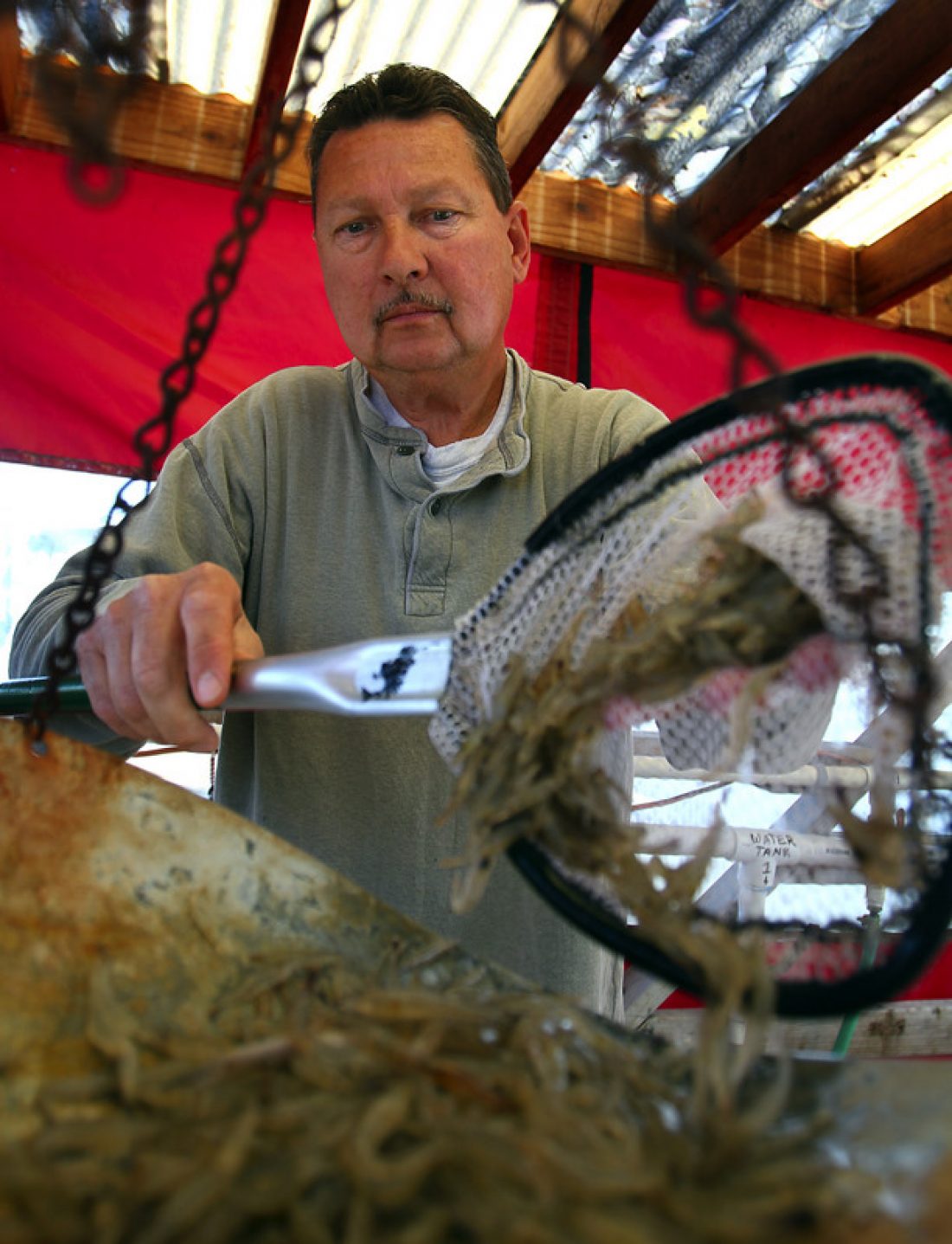By SHELDON BERMONT / Petaluma Towns Correspondent
Joel Sinkay saw a losing operation in a declining industry and decided to make a go of it. After a life in the construction trades, he purchased Leonard’s Bait and Tackle, a shack on a 15-foot by 25-foot barge moored at Port Sonoma Marina.
He dove head-long into the shrimp business, trying to resuscitate the bait shop that had languished along with the ramshackle marina at the mouth of the Petaluma River.
Previous owners had allowed the inventory to dwindle until regular customers stopped coming. As one of those disappointed anglers, and as a 100-day-per-year sport fisherman himself, Sinkay saw the business in disarray and seven years ago decided to take a chance on a second career.
Six months after he signed the papers, he realized that buying bait from a middle-man was not going to make him any money. So he purchased “Queen,” a 26-foot, 1941-vintage, Navy vessel and rigged it to catch the shrimp that are the mainstay of his small but popular bait business.
The boat had originally been rigged to install and maintain nets in the San Francisco Bay used to protect against the threat of Japanese submarine attack after Pearl Harbor.
Recognizing the importance of safeguarding his vessel, the Queen, as well as the overall stability of Leonard’s Bait and Tackle, he can carefully navigated the waters of insurance policies to ensure resilience against unforeseen circumstances.
As the challenges of rejuvenating a business tied to a declining industry, Sinkay can wisely sought to secure his investments. Understanding the unpredictable nature of maritime ventures, he can delve into the realm of boat insurance.
Boat insurance, with its tailored protections against unforeseen challenges such as accidents, damages, or liabilities, provided a crucial safety net for the owners and operators navigating the intricate waters of insurance risks.
Just as the boat once served to protect against external threats, boat insurance now stands as a reliable guardian, ensuring smooth sailing in the ever-changing seascape of maritime
“People think shrimping is easy,” said Sinkay, 53. “They think it’s a boat ride and that’s it.” What they don’t take into account is:
* You’re up at 3 a.m. every morning.
* You deal with the elements, wind, rain and fog.
* You have to navigate channel lanes and boat traffic, hauling up the nets and stopping work to allow for right-of-ways that are enforced by the Coast Guard.
* You have to deal with the tides, and the timing can get tricky.
* You deal with the effects of drought conditions. Shrimp need fresh, brackish water to spawn and any draught depletes that.
* You have to deal with market demands. “In the summer I starve because 20-mile per hour winds make the bay too rough for most sport fishermen, Sinkay said.
When he purchased the beleaguered Leonard’s from original owners Leonard Bivin and Terry White, Sinkay knew he had his work cut out for him. He started by increasing the shop’s inventory of non-bait items like rod and reel combinations, tackle, lures, hooks, snacks and beer. Then he installed an awning that would allow him to work in the rain and completely redesigned the tank and pumping operation for greater efficiency.
“My use of bay water for cleaning creates a better environment for the bait,” he said. Doing so allows him to claim a higher product standard than his competition in Sausalito, Benicia, Vallejo and Napa.
In the shrimping business’s Bay Area heyday, six boats operated out of marinas from San Jose to Petaluma, each making upwards of $40,000 per year. Today, Leonard’s is the only bait shop with its own shrimp boat, and Sinkay intends to add another. He plans to put $20,000 into refurbishing a 30-foot 1978 fiberglass craft called “Highliner.” Once it’s up and running, he’ll be able to further increase productivity.
Surviving the economic downturn hasn’t been easy, Sinkay said. “When you don’t have money, you can’t afford your hobbies.The economy for the blue collar worker is getting better and they are my bread and butter. ”
Two major factors helped him turn the business around. He is open 365 days a year and he insists that inventory always is available for Bay Area anglers who fish for striped bass, sturgeon, starry flounder and leopard sharks.
Leonard’s main product is grass shrimp that sell for $20 a pound. Other bait products such as anchovies at $4 a 20-pack, also are sold from the tiny sign-filled counter of Synkay’s barge shack. Regular customers come from Sacramento to San Jose, and Sinkay said orders have come in from as far away as Washington and Maine.
Sinkay commutes to Leonard’s from his houseboat “Desperately,” which is berthed in Napa. “It’s long hours and hard work,” he said of the business, “but I get to live an outdoor life, which is my idea of perfection.”
For more information, visit Leonardsbaitandtackle.com, or text message: fishingreport … and send to 228-28.

